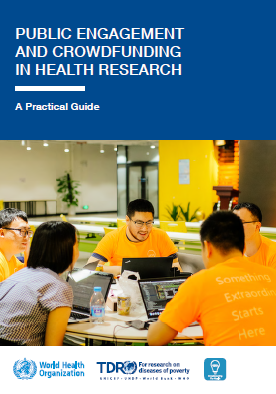TDR/Regional Office-funded research in scientific press (1993–1999)
Reference list
Leishmaniasis
- Kamhawi A, et al. Environmental manipulation in the control of a zoonotic cutaneous leishmaniasis focus. Archive de L’Institut Pasteur de Tunis, 1993, 70(3–4):383–90. |PubMed|
- Arbaji AK, Gradoni L, Gramiccia M. Leishmanin skin test survey in a focus of high endemicity of Leishmania major in Jordan. Acta tropica, 1993, 54(1):77–9. |PubMed|
- Janini R, et al. Incrimination of Phlebotomus papatasi as vector of Leishmania major in the southern Jordan Valley. Medical and veterinary entomology, 1995, 9(4):420–22. |PubMed|
- Mengad R, et al. Production of direct agglutination test (DAT) antigen and seroprevalence of visceral leishmaniasis in northern Morocco. Giornale Italiano di medicina tropicale, 1998, 3(3–4):83–7.
- Mengad R, et al. Production of direct agglutination test (DAT) antigen and seroprevalence of visceral leishmaniasis in the northern of Morocco. Eastern Mediterranean health journal, 1999, 5(5):1091.
- Sassi A, et al. Leishmanin skin test lymphoproliferative responses and cytokine production after symptomatic or asymptomatic Leishmania major infection in Tunisia. Clinical and experimental immunology, 1999, 116(1):127–32. |PubMed|
- Al-Shamahy H. Seroprevalence of kala-azar among humans and dogs in Yemen. Annals of Saudi medicine, 1998, 18(1):66–8. |PubMed|
- Ibrahim ME, et al. Kala-azar in a high transmission focus: an ethnic and geographic dimension. The American journal of tropical medicine and hygiene, 1999, 61(6):941–4. |PubMed|
- Elnaiem DA, et al. Impact of pyrethroid-impregnated curtains on Phlebotomus papatasi sandflies indoors at Khartoum, Sudan. Medical and veterinary entomology, 1999, 13(2):191–7. |PubMed|
Lymphatic Filariasis
- Baraka OZ, et al. Community based distribution of ivermectin in eastern Sudan: acceptability and early post-treatment reactions. Transactions of the Royal Society of Tropical Medicine and Hygiene, 1995, 89(3):316–18.|PubMed|
- Ramzy RMR, et al. Field evaluation of a rapid-format kit for the diagnosis of bancroftian filariasis in Egypt. Eastern Mediterranean health journal, 1999, 5(5):880–7. |PubMed|
Malaria
- Ghrab J, Bouattour A. Etude experimentale de l’efficacite larvivore de Gambusia affinis holbrooki (Girard, 1859) (Poisson-Poecilidae). Archive de L’Institut Pasteur de Tunis, 1999, 76(1–4):33–38. |PubMed|
Schistosomiasis
- Moukrim A, Zekhnini A, Rondelaud D. Observations ecologiques sur les hotes ntermediaires de Schistosoma haematobium Bilharz dans la province d’Agadir (Maroc). Bulletin de la Société Française de Parasitologie, 1993, 11(2):223–30.
- Zekhnini A, Mansir A, Moukrim A. Nouvelles donnees sur les hotes intermediaires de Schistosoma haematobium dans la province d’Agadir (Maroc). La penetration du miracidum et son devenir chez trois pulmones. Bulletin de la Société Française de Parasitologie, 1993, 11(1):85–94.
- Al-Haddad AM. Research Abstract. New foci of schistosomiasis transmission in Yemen. Eastern Mediterranean health journal, 1995, 1(2):294–96.
- Hilali AH, et al. Infection and transmission pattern of Schistosoma mansoni in the Managil irrigation scheme, Sudan. Annals of tropical medicine and parasitology, 1995, 89(3):279–86. |PubMed|
- Attallah AM, El-Masry SA. Detection of circulating antigens in individuals infected with schistosomiasis using monoclonal antibodies and fast dot-ELISA. Eastern Mediterranean health journal, 1996, 2(2):340.
- Farag H. Evaluation of an integrated approach to schistosomiasis control in a resettlement area west of Alexandria. Eastern Mediterranean health journal, 1996, 2(3):558–59.
- Hammad TA, et al. Comparative evaluation of the use of artificial neural networks for modeling the epidemiology of Schistosoma mansoni. Transactions of the Royal Society of Tropical Medicine and Hygiene, 1996, 90(4):372–6. |PubMed|
- Moukrim A, Zekhnini A, Rondelaud D. Schistosoma haematobium: influence of the number of miracidia on several characteristics of infection in newborn Planorbarius metidjensis. Parasitology research, 1996, 82(3):267–9. |PubMed|
- Attallah AM, et al. Fast-dot ELISA using urine, a rapid and dependable field assay for diagnosis of schistosomiasis. Journal of the Egyptian Society of Parasitology, 1997, 27(1):279–89. |PubMed|
- Zekhnini A, et al. Schistosoma haematobium: comparative studies on prevalence and cercarial shedding according to the shell diameter of Planorbarius metidjensis at miracidial exposure. Parasitology research, 1997, 83(3):303–5. |PubMed|
- Attallah AM, et al. Immunochemical purification and characterization of a 74.0-kDa Schistosoma mansoni antigen. Journal of parasitology, 1998, 84(2):301–6. |PubMed|
- Attallah AM, et al. Immunochemical characterization and diagnostic potential of a 63-kilodalton Schistosoma antigen. The American journal of tropical medicine and hygiene, 1999, 60(3):493–7. |PubMed|
- Attallah AM, et al. Rapid detection of a Schistosoma mansoni circulating antigen excreted in urine of infected individuals by using a monoclonal antibody. Journal of clinical microbiology, 1999, 37(2):354–7. |PubMed|
- Yacoubi B, et al. Schistosoma haematobium: comparative studies on the characteristics of infection in three populations of Planorbarius metidjensis from the Agadir province in South Morocco. Parasitology research, 1999, 85(3):239–42. |PubMed|
- Nagi MA, et al. Epidemiological, clinical and haematological profile of schistosomiasis in Yemen. Eastern Mediterranean health journal, 1999, 5(1):177–81. |PubMed|








